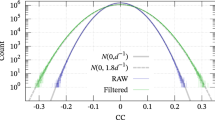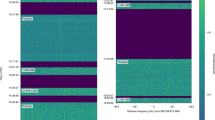Abstract
ROHAN et al.1 have observed, at Salisbury, Australia, what they describe as a ‘peculiar phenomenon’ when monitoring signals from Station GBR, Rugby, England, on 16 kc/s. The normal beat frequency, derived from the comparison of the received signal with a locally generated high-stability oscillator, on four specified dates suddenly increased for periods lasting 8–30 min. These disturbances were not observed by the British Post Office at Dollis Hill; the signal transmitted by GBR must therefore be assumed to have been normal. Furthermore, Station NBA, Panama Canal Zone, operating on 18 kc/s, compared with the same locally generated source, did not exhibit the same phenomenon. Allan2 confirms that very similar results were also obtained at Lower Hutt, New Zealand, on at least two of the dates mentioned, and anomalous records were obtained at the Wellington Time Service Observatory on the two remaining dates. Typical frequency deviations from normal on these occasions ranged from 4 to 13 parts in 108, and the amplitude of the anomalous signal is quoted as 4–5 times greater than normal. Allan concludes that a powerful and frequency-stable transmitter, situated relatively near Australia and New Zealand, is able to operate on 16 kc/s.
This is a preview of subscription content, access via your institution
Access options
Subscribe to this journal
Receive 51 print issues and online access
$199.00 per year
only $3.90 per issue
Buy this article
- Purchase on Springer Link
- Instant access to full article PDF
Prices may be subject to local taxes which are calculated during checkout
Similar content being viewed by others
References
Rohan, P., Anderson, L. L., and Cooke, D. J., Nature, 197, 783 (1963).
Allan, A. H., Nature, 199, 582 (1963).
Allan, A. H., Nature, 201, 1016 (1964).
Round, H., Eckersley, T. L., Tremellen, K. W., and Lunnon, F. C., J. Inst. Elect. Eng., 63, 933 (1925).
Author information
Authors and Affiliations
Rights and permissions
About this article
Cite this article
ISTED, G. Anomalous Reception of Very-low-frequency Signals in Australia and New Zealand. Nature 202, 994–995 (1964). https://doi.org/10.1038/202994a0
Issue Date:
DOI: https://doi.org/10.1038/202994a0
This article is cited by
Comments
By submitting a comment you agree to abide by our Terms and Community Guidelines. If you find something abusive or that does not comply with our terms or guidelines please flag it as inappropriate.



